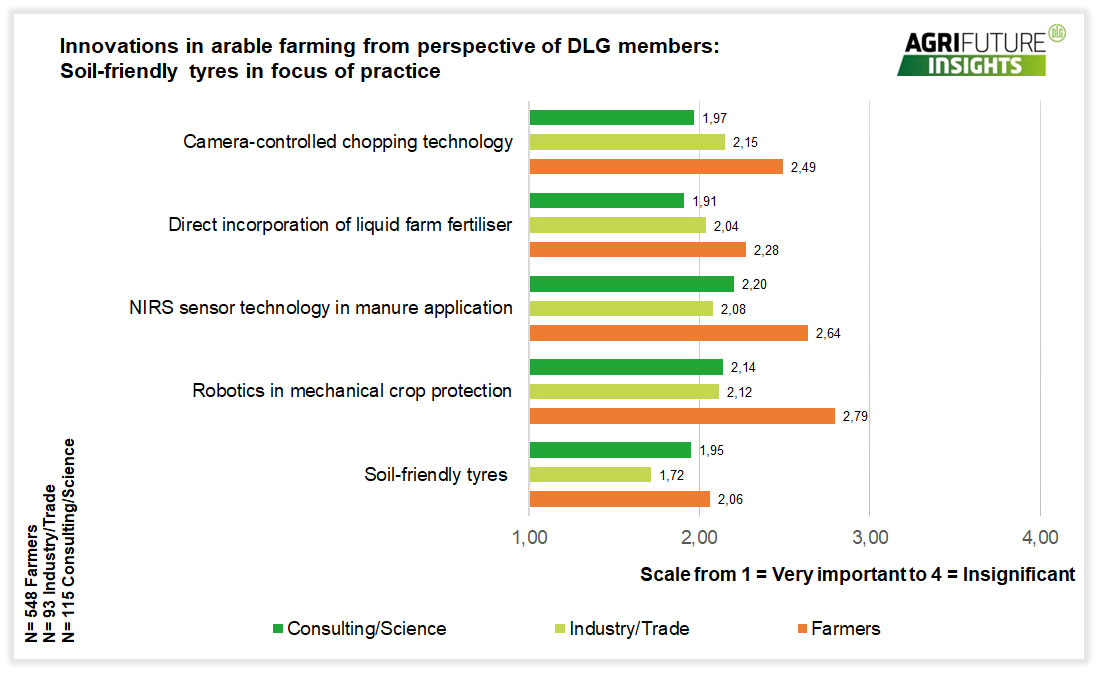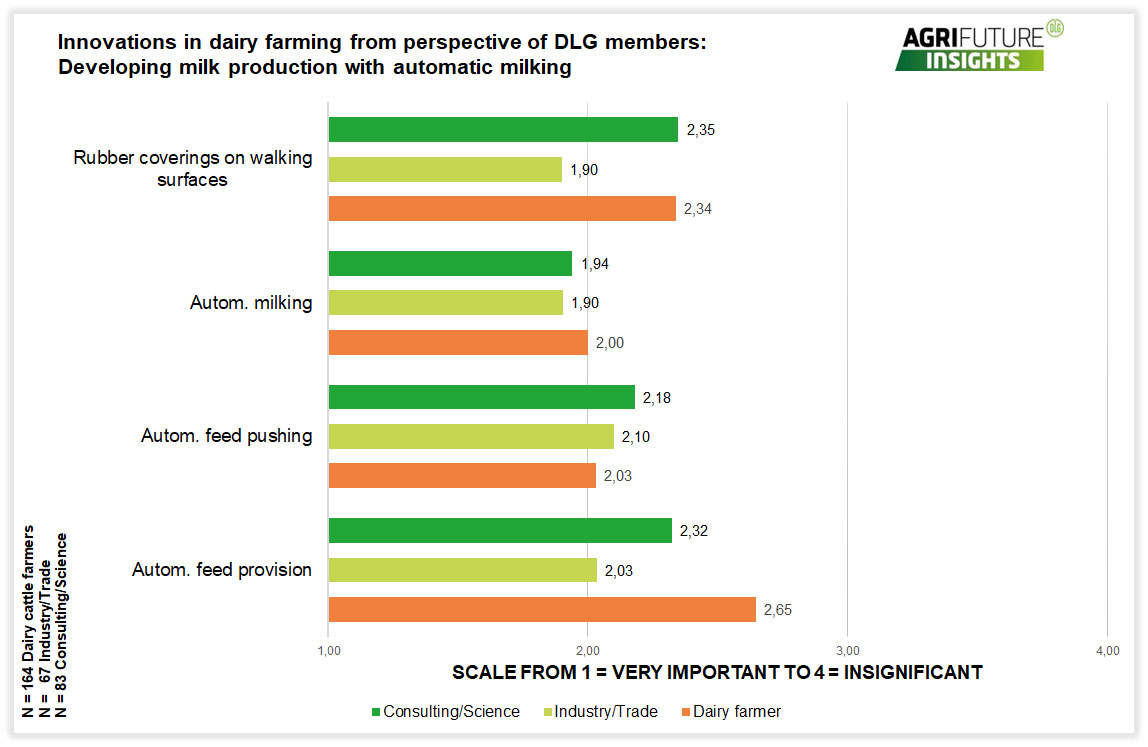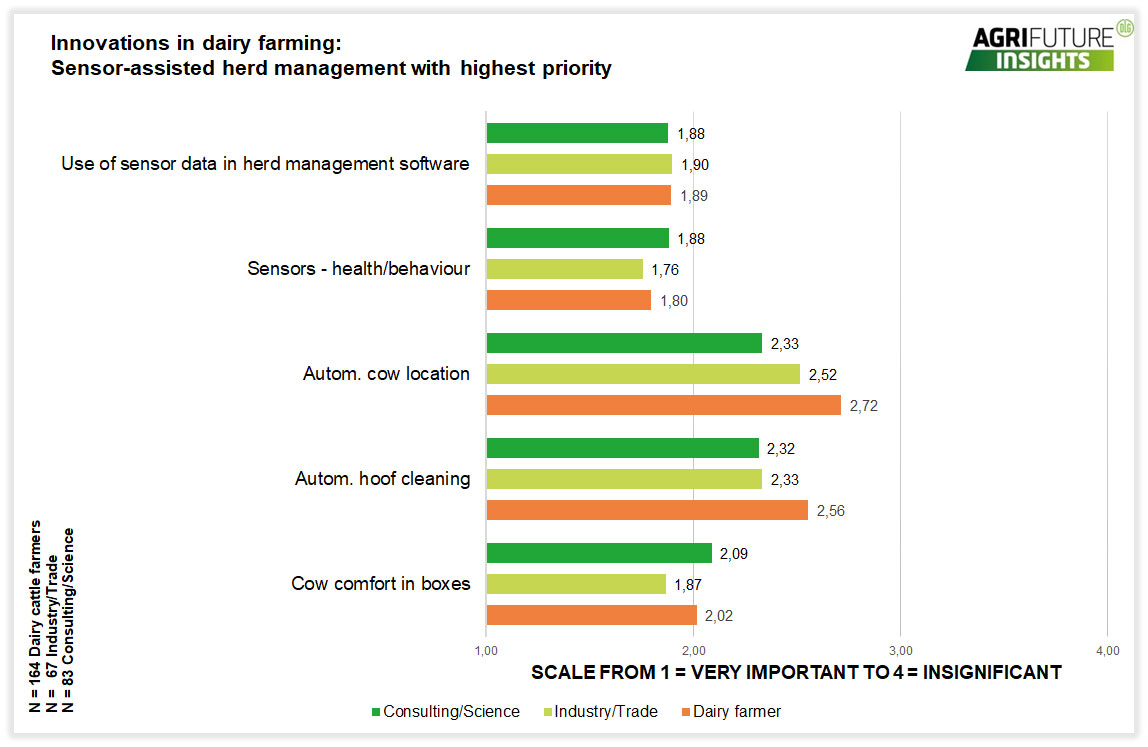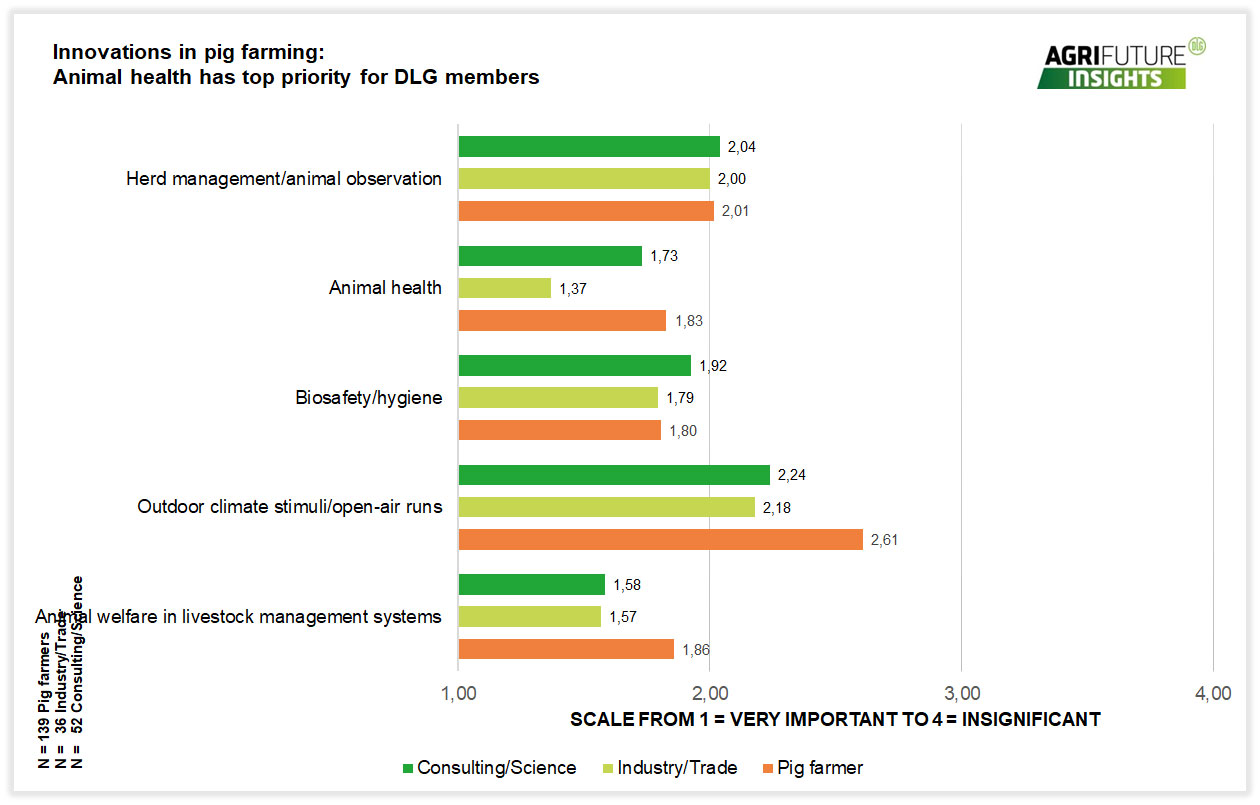Innovations for agriculture: DLG members set these priorities
By Achim Schaffner and Erik Guttulsröd
The participants in the survey rated the importance of various innovation areas on a scale between 1 (= very important) and 4 (= insignificant).
Arable Farming
In the field of arable farming, the most important innovations mentioned were soil-friendly tyres, robotics in mechanical crop protection, NIRS sensors in manure application and direct incorporation of liquid fertilisers (see Fig. 1).
Soil-friendly tyres
Soil-friendly tyres are important for the responding farmers. Soil protection or the avoidance of soil compaction is generally a high priority in order to maintain the rootability of the soil, its water-holding capacity and vital soil life. In addition, due to changing climatic conditions – and therefore also weather conditions – the time windows for the optimal trafficability of the soils tend to narrow. Under these conditions, tyres that are gentle to the soil play an important role in soil protection and the timely cultivation of the land.
Survey participants from industry and commerce attach even greater importance to tyres that are gentle to the soil than farmers do. For equipment manufacturers in particular, soil-friendly tyres are a prerequisite for the use of the machines they produce and therefore for their acceptance by farmers.
Dairy cattle farming
In dairy farming, the participants in the survey rated the importance of digitalisation in the barn, cow comfort and automation of daily routine tasks (see Fig. 2 and Fig. 3).
Digitalisation in the barn
Digitalisation in the barn is highly significant for the further development of husbandry practices, as the results of the DLG member survey show. The participating dairy farmers consider the use of sensors for herd management and for monitoring animal health to be important to very important. Sensors monitor animal behaviour around the clock, and if an animal deviates from the herd's behaviour, farmers receive a message. The herd is comprehensively monitored with the "digital shepherd", so sensors bring real added value to animal health management and oestrus detection. In addition, the data collected by the sensors is an important component for decision support in herd management. The dairy farmers therefore also consider the direct feeding and evaluation of sensor data in herd management software to be important.
Cow comfort
Cow comfort is also important to farmers. Because despite years of experience, innovative stall separations and comfort mattresses can increase cow comfort. A divergent assessment between farmers and participants from the industry can be seen in the evaluation of the importance of rubber coverings on walking surfaces as a partial measure to increase cow comfort. While participants from industry and commerce rate rubber coverings on walking surfaces as important to very important, consultants and practitioners rate this approach as comparatively less important.
Automation of daily routine tasks
In addition to supporting herd management with sensor technology, the automation of daily routine tasks plays an important role in the further development of husbandry methods in milk production. The DLG members taking part in the survey are particularly interested in automatic milking and automatic feed pushing. This is because automatic milking frees up labour capacity that can be used for animal observation and follow-up checks. It reduces the manpower required for milking and relieves farm managers in their search for competent staff, which is an important factor in view of the shortage of labour.
Automatic feed pushing is also rated as important by the participants in the survey. Because this automation creates leeway for other activities in the company. In addition, more regular feed pushing can be implemented via automation, which leads to a higher feed utilisation. This is an important aspect, especially in organic dairy farming with reduced use of milk performance feed.
Pig farming
In the field of pig farming, the DLG member survey rated the importance of outdoor climate stimuli, animal welfare, herd management and animal observation (see Fig. 4).
Outdoor climate stimuli
Livestock farming must be oriented towards the needs of the animals – this is a central social demand placed on animal owners. Organic pig farming has adapted to this with open-air runs, more space and straw bedding to keep the pigs occupied, as well as feed largely from the farm itself or from cooperative farms.
The practitioners participating in the DLG member survey rated the central importance of outdoor climate stimuli for pigs in organic pig farming as important to rather less important. Often, old buildings cannot be converted or can only be converted at great expense, so that outdoor areas are sometimes not feasible for those interested in conversion. However, outdoor climate stimuli are central factors for animal-friendly pig husbandry. This is why the run is a central functional area in organic pig farming, without which the sty system would not work. In contrast to the pig farmers participating in the survey, participants from industry and trade, as well as from consultancy and science, attach greater importance to outdoor climate stimuli. This shows that both groups are working to further establish free-range husbandry.
Favourable conditions for entry into organic pig farming
For pig farmers interested in conversion, the conditions for entering organic pig farming are favourable due to the increasing demand for organic pork. Interested parties should intensively analyse the operational conditions from the perspectives of the market and production, as well as structural conditions with specialised advisors. This also applies to marketing and the conclusion of marketing contracts. Because these are often concluded for longer periods of time and should therefore be intensively prepared.
Animal welfare, herd management and animal observation
The DLG members participating in the survey rated the animal welfare of the livestock management systems as important to very important. This shows that the animal welfare of husbandry practices is a major factor in the further development of pig farming for which practical solutions are being sought. Developers from industry and consultants rate the topic as even more important than participants from practice.
The participants in the survey rate the importance of herd management and animal observation almost equally – all respondents consider the topic important. This is because the early detection of possible diseases is indispensable for initiating countermeasures. The various functional circles of resting and sleeping behaviour, locomotion behaviour, foraging behaviour, reproductive behaviour, social behaviour, comfort and exploration behaviour and excretory behaviour are observed in order to assess the vitality of the herds. Within these functional circles, the pig farmers can assess the status of the animals on the basis of behavioural indicators.
Briefly summarised
The results of the DLG member survey show: The further development of agricultural production towards sustainability is in full swing. Central fields of innovation are mechanical weed control, digital support for herd management in dairy farming and the animal-friendly further development of husbandry methods in pig farming. Organic farmers are important development partners, because practical experience is available from many years of applying technology in the fields. The answers of the DLG members from the areas of industry/trade and consulting/science show that the experts are working in particular on the areas of mechanical weed control and animal-friendly pig farming. This suggests results that are relevant for practice in the future.
Dr Achim Schaffner, DLG, Project Manager Farm Management and Organic Farming and
Erik Guttulsröd, Division Manager Farm Management and Sustainability,DLG
The article was first published in BioTopp, issue 3/2021.






